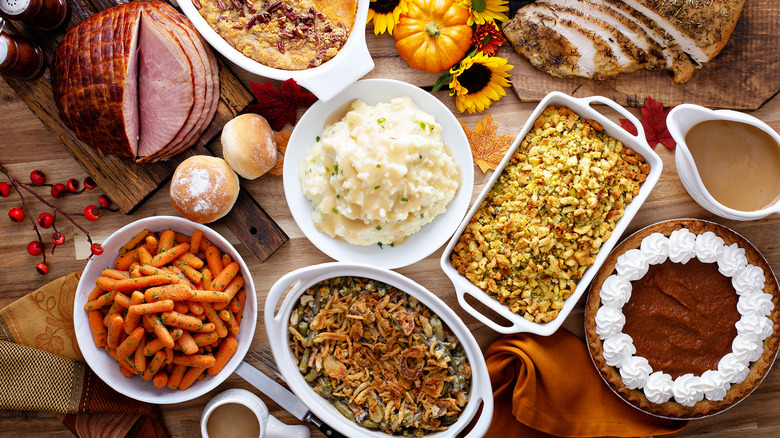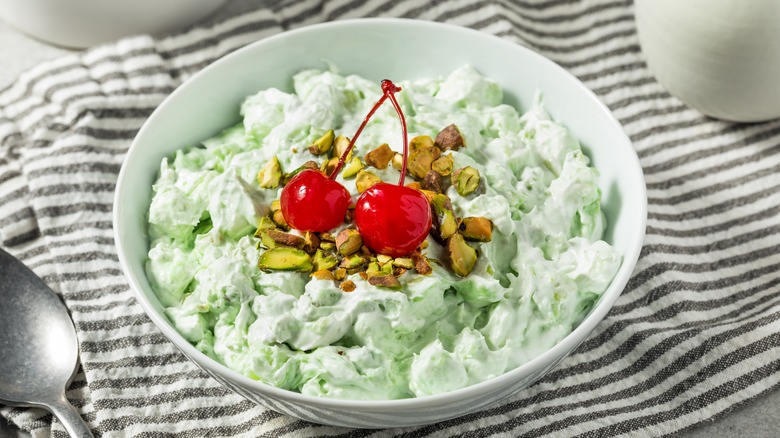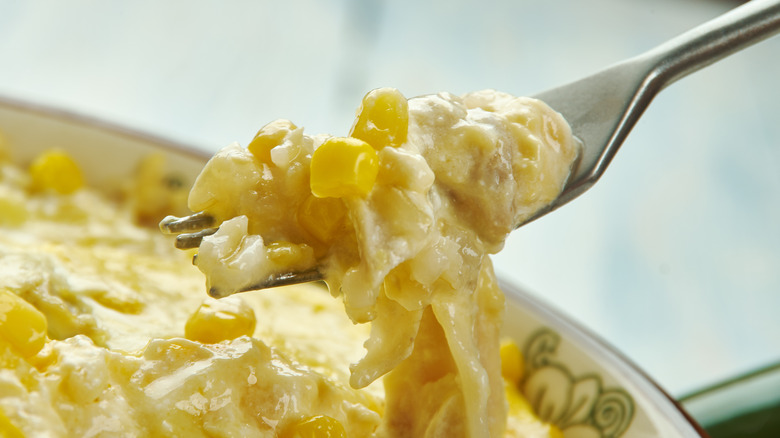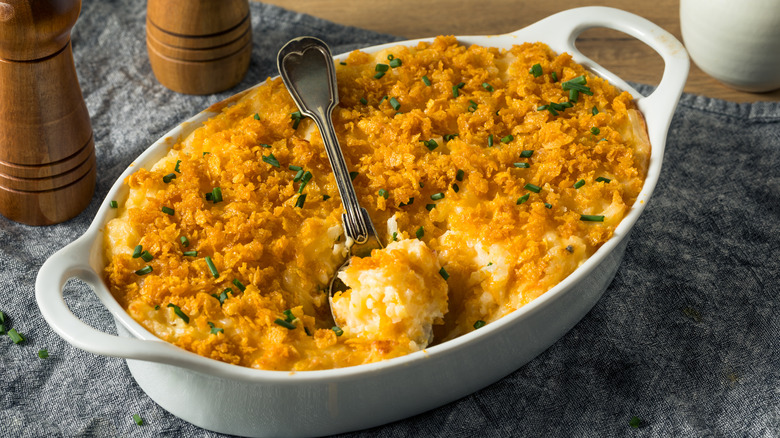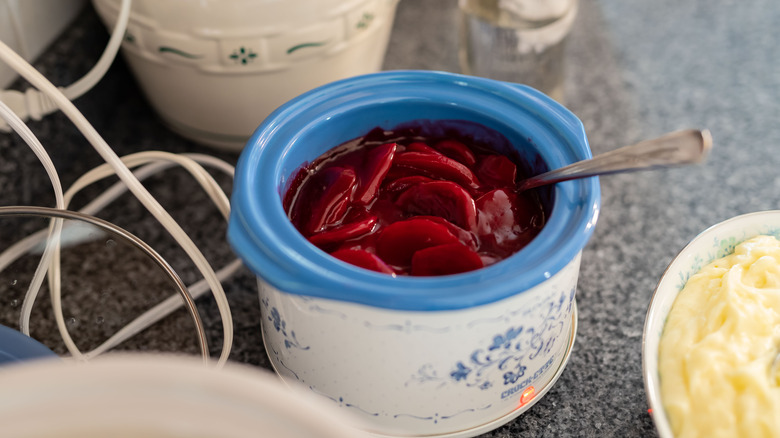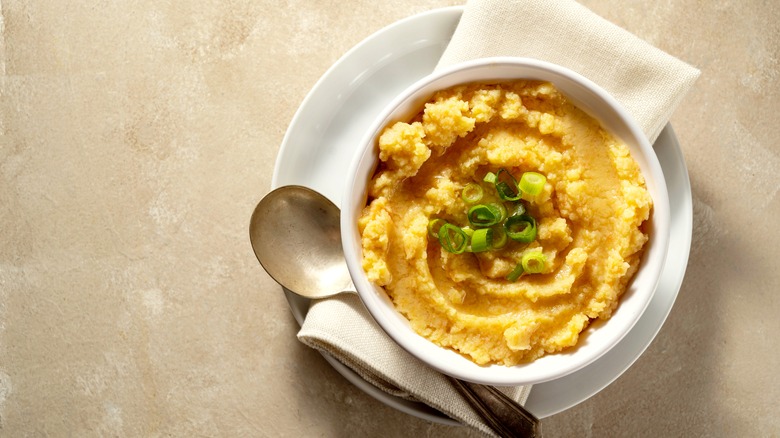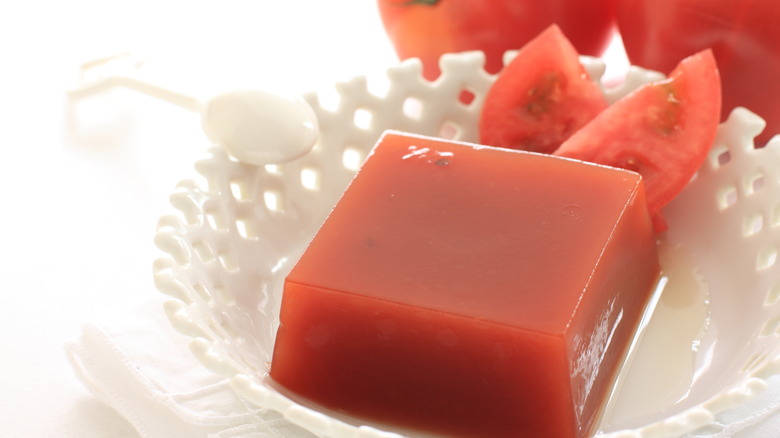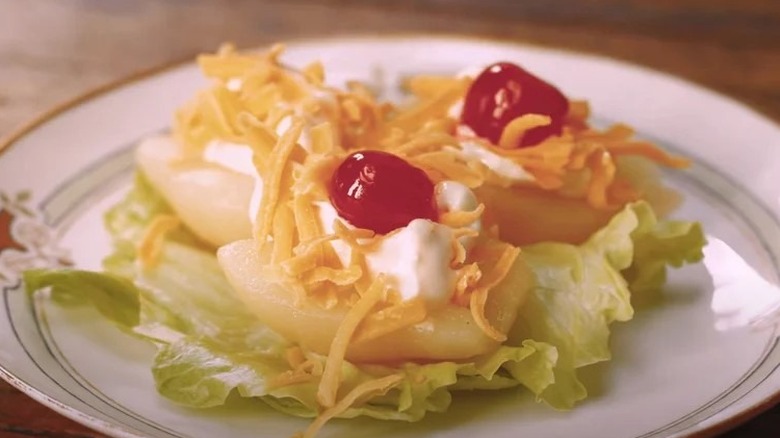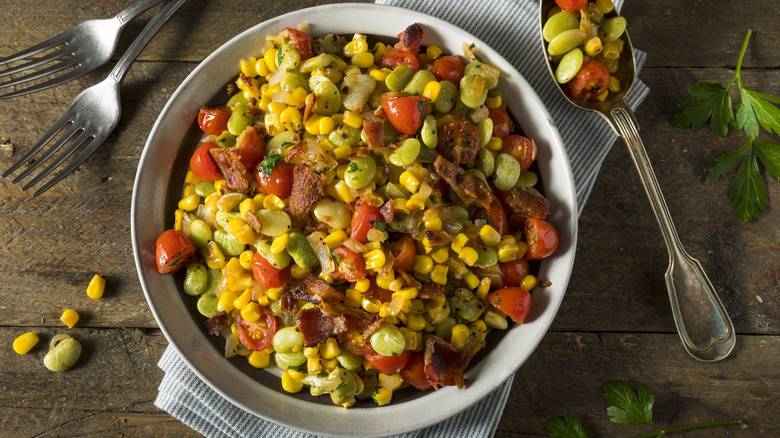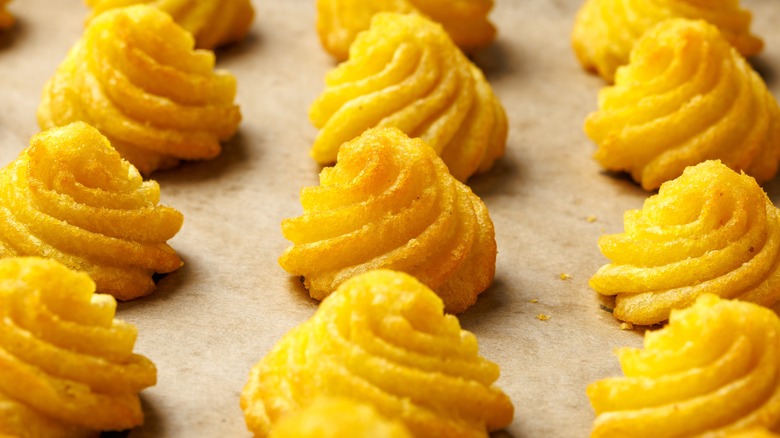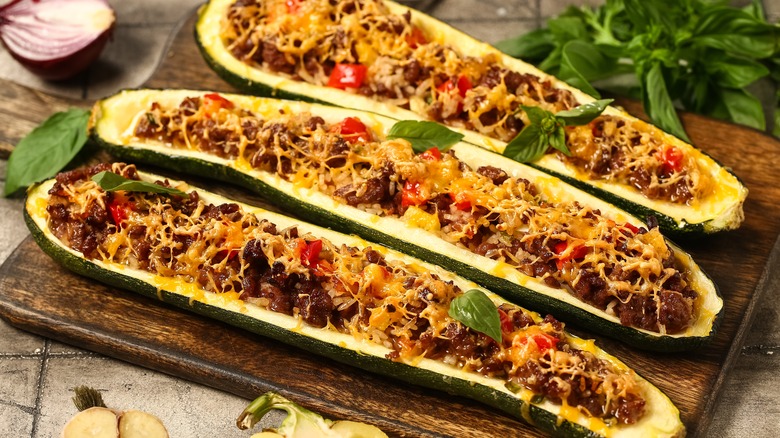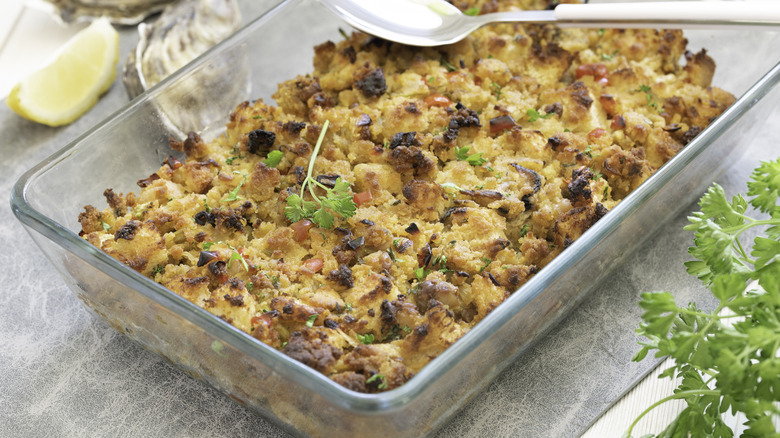11 Vintage Side Dishes Barely Anyone Makes Anymore
Side dishes can make or break a dinner. We've all had meals elevated by the perfect pairing of main course and side, as well as feasts where the side dishes dominated the conversation while the main courses slipped our minds. And, of course, some side dishes are so iconic they become the first thing that comes to mind when planning out a grand occasion, such the ever-dominant roasted potatoes.
At the same time, some side dishes just don't make the grade. Plenty of vintage side dishes start out as standards or classics and end up in the back of the fridge, metaphorically speaking. Barely anyone remembers the side dishes of the 1950s and 1960s or, if they do remember, they regard them as novelties of yesteryear. Even side dishes from the 1970s and 1980s can seem almost alien to modern palates. What were these now-little remembered sides? And which, if any, of them deserves a reprieve in the current cooking climate?
Watergate salad
This is the political joke that is also a food. The name probably has something to do with the Watergate scandal which brought down President Richard Nixon's administration, but what the actual punchline is supposed to be remains unclear. It might also have to do with the similarly named, similarly hued, and similarly nutty Watergate cake, but then again that also has nothing to do with either Nixon or the actual Watergate hotel. Maybe it really is pure coincidence; pistachio pudding hit the markets not too long before the Watergate scandal unfolded, and perhaps the association just kind of stuck in the minds of 1970s Americans.
For the uninitiated, watergate salad is an old-school dessert salad similar to ambrosia, made with pistachio pudding, crushed pineapple, mini-marshmallows, and pistachios. Yet surprisingly, given its ingredients list, Watergate salad was counted among the side dishes during its brief heyday. Now, barely anyone remembers it exists, let alone enjoys it as a side or a dessert.
Scalloped corn
Despite the name, scalloped corn does not contain shellfish. However, it's possible that scalloped corn was actually cooked in scallop shells when the dish was first invented, which would make the name far more literal than anyone could have imagined. But that theory has never been explicitly confirmed, and the name could just as likely just refer to cooking the corn in cream and/or butter, with most scalloped corn recipes reaching for the butter rather than the cream.
In either case, scalloped corn is a creamy, buttery corn casserole often mixed or topped with breadcrumbs for a little contrasting texture and possibly bacon for fun. As befits such a rich, comforting sample of American cuisine, it used to be a big deal during the Thanksgiving season, where it added another layer of warmth next to the mashed potatoes and stuffing. Sadly, this gooey side has quietly dropped off the map over the past few decades, possibly because, even for Thanksgiving, it was just too heavy.
Potato casserole
Barely anyone outside of Utah makes potato casserole anymore, where it also goes by the distinctly morbid name of funeral potatoes. Surprisingly, the name actually stems from a place of community rather than gallows humor: A potato casserole can feed a lot of people at once, who may be gathered for funerals and (presumably) other events like parties.
To say funeral potatoes are popular in Utah, where they were possibly invented, is an understatement. It's considered a staple in Church of Latter-Day Saints culture, and even appeared on commemorative pins at the 2002 Winter Olympics, hosted in Salt Lake City. Outside of Utah, however, potato casserole is considered vintage and rarely makes an appearance on the side dishes table. That is surprising to us, since it's basically a compendium of everyone's favorite comfort foods in a casserole dish: potatoes, cream, cheese, and crispy breadcrumbs. Perhaps it's no surprise it's served when lots of people might need a pick-me-up.
Harvard beets
An invention of New England, beets are already a sweet root vegetable, but Harvard beets turn that sweetness up a notch or two. Simply take roasted beets, toss them in a double boiler with sugar, vinegar, and cornstarch, and you end up with a ruby-red, sweet and sour side dish that goes well with chicken or steak. The cornstarch is the secret to the dish's success: It thickens the sauce and makes it feel luxurious rather than just wet.
Even in its native Northeastern states, barely anyone makes Harvard beets anymore. Perceptions of the taproot veggie being vintage plagues it in the modern era. The most common question people ask about it is why it has that name, and the most common answer to that query is that the dish's unique color resembles that of Harvard University's football jersey. But it isn't a settled debate, and some theorists claim it was actually invented in a tavern in England, named Harwood, and got its name by way of a mispronunciation.
Mashed turnips
Before the 1980s, mashed potatoes had competition on the Thanksgiving table. Mashed turnips were the side dish of choice for millions of Americans, with a long, long history behind them — possibly up to 4,000 years. Turnips are inexpensive (especially in winter) and easy to store, making them an ideal holiday side. They were a huge favorite during the World Wars as they helped keep people fed during hard rationing periods. Also, with some butter and cream, mashed turnips scratch the same itch as mashed potatoes, albeit with a slight peppery edge. Before the '80s, it seemed like this would be a holiday food rivalry to last for ages.
After the Reagan years, though, suddenly mashed turnips stopped showing up. Barely anyone makes them anymore, even though the humble tuber still has its defenders. What happened? Well, the turnip's humble nature might have proved a double-edged sword. People started to see the turnip as being low class and thus something to avoid.
Tomato aspic
In the 1950s and 1960s, gelatin-based foods were beyond cool: They were futuristic. With the advent of instant gelatin, these dishes came from little packages you could just grab off the shelf. With just a little preparation and few additions, you had a glossy, jiggly, and eye-catching dish that everyone could stop and admire. And all of that is before looking into the long history of gelatin dishes, which date back to the medieval period in Europe.
Tomato aspic, in particular, had a life of its own in the Southern United States, where it appeared at luncheons and dinner parties on a regular basis. If you're unfamiliar, imagine it sort of like a solid-but-jiggly tomato soup. This was the height of elegance for decades, and yet, it slowly faded from the culinary scene even in its former strongholds. Possibly the novelty wore off, and possibly the rise of other convenience foods made it seem outdated. Either way, this former food of the future feels vintage to modern eaters.
Southern pear salad
Even in its native South, Southern pear salad is divisive, to say the least. Canned pear halves are served with generous dollops of mayonnaise, a sprinkling of Cheddar cheese, a maraschino cherry, and a light bed of lettuce. On the surface, it kind of stretches the definition of the word "salad," but there is lettuce, so it probably still counts.
The history of the Southern pear salad is longer than you might expect. It appears to stem from the turn of the 20th century, when canning was still a novelty and convenience was a major factor in cooking decisions. It caught on in the Southern United States, where some people still remember it fondly.
This is a surprisingly balanced dish, with the sweetness of the pears balanced by the fattiness of mayo and the sharpness of the cheddar. Given the eccentric combination of flavors, though, it's not shocking that barely anyone still puts a Southern pear salad together.
Classic succotash
There are vintage side dishes and then there is succotash. Succotash has a long history and was once so popular a well-known Looney Tunes catchphrase is based off of it. Admittedly, it is a fun name to say. How far back does it go? All the way to pre-colonial America and to Native American cooking.
The name of succotash is based off of the Narragansett word "msíckquatash," which refers to the whole corn kernels that still appear in modern versions of the dish. Among other side dishes, succotash has demonstrated incredible flexibility. From the beginning, it's featured a combination of boiled corn and boiled beans, but beyond that, as it traveled the United States, succotash took on new features as regional chefs added their distinct vegetables and flavors, like zucchini in the Midwest and okra in the South. Bacon makes a nice addition to succotash, too.
Now, though, succotash is a rarity. Barely anyone remembers it's an actual dish and not just something Sylvester the Cat yells out. Unfortunately, canned versions and poor cafeteria preparations seemingly shifted an entire generation's opinion of this historical side dish.
Potato puffs (duchess potatoes)
Potato puffs, sometimes called duchess potatoes, still has defenders. You may yet find it on holiday tables in lieu of mashed potatoes, but other than those rare instances, good luck finding it anywhere in the United States.
You can think of potato puffs as French fries with extra pedigree, and a history dating back to the 1700s. They are creamy on the inside with a crispy golden crust on the outside and very often piped into decorative shapes for extra attractiveness. There seemed to be a moment when it looked like duchess potatoes would seize the potato crown and be the definitive potato preparation. And then they didn't.
It's not actually clear why this side dish went from standard cooking to vintage. Some argue that they're rather finicky and too difficult to make easily. Others say they don't hold their shape well, thus making all that hard work pointless. Additionally, they can be drier than mashed potatoes, which possibly limits their mass appeal.
Zucchini boats
Zucchini boats, a nautically shaped variation of classic stuffed vegetables, hollow out roasted zucchinis and fill them with all sorts of good stuff before another trip into the oven. The origins of this dish in America are a little vague, but it's believed that zucchinis originated in Italy and arrived with immigrants in the 1920s. The mild taste of zucchinis makes them an ideal platform for stronger flavors, and the speed and seeming ease of cooking them made them very appealing to convenience-driven home cooks.
As time wore on, however, zucchini boats began to look less than seaworthy. It turns out if zucchini boats are not cooked perfectly, the texture leaves a lot to be desired. Too short a stint in the oven and the zucchinis' flavor becomes bland. Leave them in too long, though, and the boats end up soggy. But when zucchini boats are properly prepared, they truly do hit like no other vegetable side dish, vintage or otherwise.
Oyster stuffing and dressing
Barely anyone remembers that, in eras past, everyone put oysters in their stuffing for holiday meals. This was true at every single holiday and special occasion. For those allergic to shellfish, it was not a welcoming time. In the late 19th century, oysters were almost universally beloved across the United States. With the advent of train transportation, shellfish could be freshly delivered anywhere, and because they were so plentiful, they were fairly inexpensive. The average American would eat hundreds of oysters a year. On Thanksgiving, they weren't just in the dressing but in the turkey itself.
A number of factors ended up bringing the oyster years to their end. Overfishing caused oyster prices to skyrocket, and more scrutiny on the fishing industry's sanitation practices made oysters feel unclean and unsafe to a lot of Americans; they were connected to serious typhoid outbreaks in 1924 that seriously degraded how most people saw them. Now, you're lucky to find oysters even on the menus outside of seafood restaurants, much less at the holiday table.

